Analysis of Schizophrenia Etiology Theories in Mental Health Nursing
VerifiedAdded on 2022/07/27
|13
|3705
|13
Report
AI Summary
This report critically discusses the etiology of schizophrenia, a severe mental condition characterized by abnormal interpretations of reality, hallucinations, and thought disorders. The report analyzes three key theoretical models: genetic, environmental, and vascular inflammatory theories, using a c...
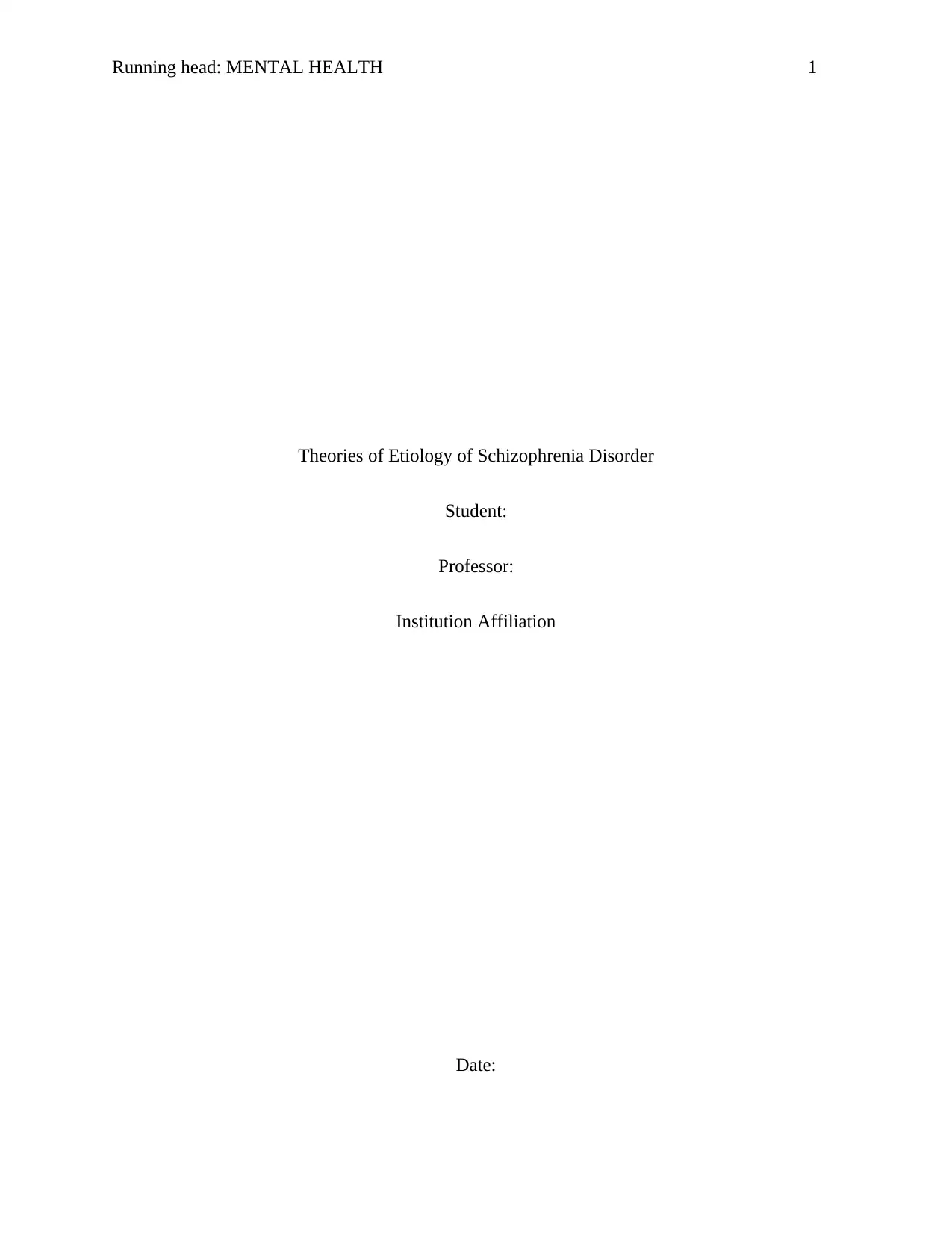
Running head: MENTAL HEALTH 1
Theories of Etiology of Schizophrenia Disorder
Student:
Professor:
Institution Affiliation
Date:
Theories of Etiology of Schizophrenia Disorder
Student:
Professor:
Institution Affiliation
Date:
Paraphrase This Document
Need a fresh take? Get an instant paraphrase of this document with our AI Paraphraser

MENTAL HEALTH 2
Introduction
Schizophrenia (SZ) is a severe mental condition where a person with the illness
interpreted the real things in an abnormal manner. A person with mental disorder will think that
someone either, a public speaker, a famous person, or anyone giving some general life situation
examples is directing the speech or written message to him her. Some of the signs and symptoms
of the disease include hallucinations, extreme thinking disorders, and abnormal behavior, which
interfere with daily functioning. Treatment of the condition is a long-term life process
(McCarthy-Jones et al., 2017).
The current theoretical models of schizophrenia that can be useful in this paper to analyze
Jess’s condition include environmental, genetic-vascular inflammation theory, and genetic theory
of schizophrenia. Jess is a 26 years’ old who was diagnosed with schizophrenia while at the age
of 20 years. Jess receives care from her parents, support from the NDIS disability workers, and a
local general practitioner. Since there was an informed history of the illness in Jess’s family, a
genetic theory of the etiology of schizophrenia can apply to this condition. The gene-
environmental interaction theory can refer to Jess’s condition, whereby it is reported that she
acquired the abusive behavior from a grandmother who her primary caregiver. Hospitalization
due to Jess’s usage of cannabis and alcohol abuse shows the importance of analyzing the
theoretical implications of the inflammatory genetic etiology of the disease, which interconnect
the genetic and environmental factors that lead to the development of the disease (Li et al.,
2017). The etiology of this mental disorder has been poorly understood for the past several years.
Still, there is a current accumulation of evidence that has revealed that it is associated with a
range of brain abnormalities. Several postmortem studies have shown that structural post-
morphologies have been noted in enlargement of lateral and third ventricles, loss of brain frontal,
Introduction
Schizophrenia (SZ) is a severe mental condition where a person with the illness
interpreted the real things in an abnormal manner. A person with mental disorder will think that
someone either, a public speaker, a famous person, or anyone giving some general life situation
examples is directing the speech or written message to him her. Some of the signs and symptoms
of the disease include hallucinations, extreme thinking disorders, and abnormal behavior, which
interfere with daily functioning. Treatment of the condition is a long-term life process
(McCarthy-Jones et al., 2017).
The current theoretical models of schizophrenia that can be useful in this paper to analyze
Jess’s condition include environmental, genetic-vascular inflammation theory, and genetic theory
of schizophrenia. Jess is a 26 years’ old who was diagnosed with schizophrenia while at the age
of 20 years. Jess receives care from her parents, support from the NDIS disability workers, and a
local general practitioner. Since there was an informed history of the illness in Jess’s family, a
genetic theory of the etiology of schizophrenia can apply to this condition. The gene-
environmental interaction theory can refer to Jess’s condition, whereby it is reported that she
acquired the abusive behavior from a grandmother who her primary caregiver. Hospitalization
due to Jess’s usage of cannabis and alcohol abuse shows the importance of analyzing the
theoretical implications of the inflammatory genetic etiology of the disease, which interconnect
the genetic and environmental factors that lead to the development of the disease (Li et al.,
2017). The etiology of this mental disorder has been poorly understood for the past several years.
Still, there is a current accumulation of evidence that has revealed that it is associated with a
range of brain abnormalities. Several postmortem studies have shown that structural post-
morphologies have been noted in enlargement of lateral and third ventricles, loss of brain frontal,
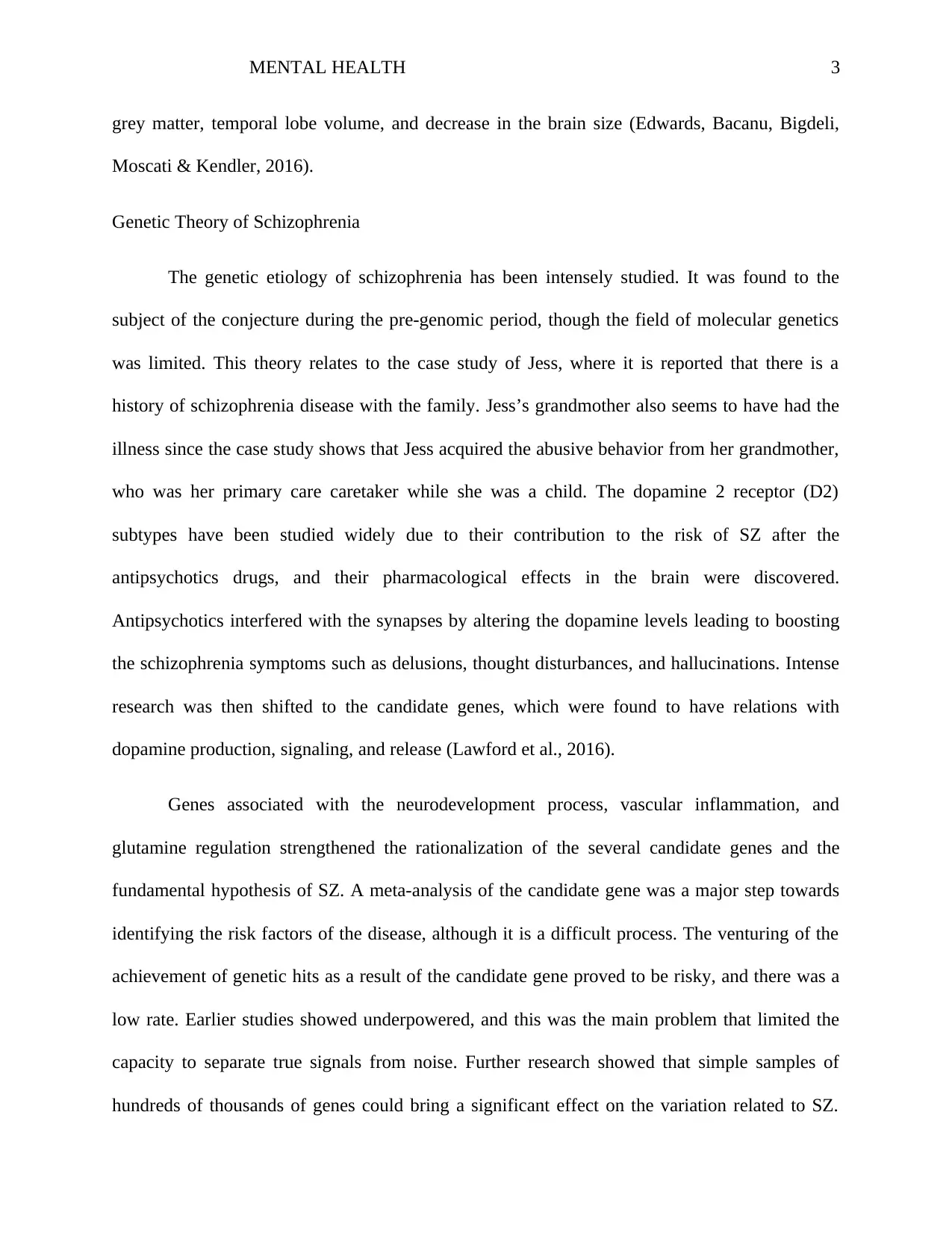
MENTAL HEALTH 3
grey matter, temporal lobe volume, and decrease in the brain size (Edwards, Bacanu, Bigdeli,
Moscati & Kendler, 2016).
Genetic Theory of Schizophrenia
The genetic etiology of schizophrenia has been intensely studied. It was found to the
subject of the conjecture during the pre-genomic period, though the field of molecular genetics
was limited. This theory relates to the case study of Jess, where it is reported that there is a
history of schizophrenia disease with the family. Jess’s grandmother also seems to have had the
illness since the case study shows that Jess acquired the abusive behavior from her grandmother,
who was her primary care caretaker while she was a child. The dopamine 2 receptor (D2)
subtypes have been studied widely due to their contribution to the risk of SZ after the
antipsychotics drugs, and their pharmacological effects in the brain were discovered.
Antipsychotics interfered with the synapses by altering the dopamine levels leading to boosting
the schizophrenia symptoms such as delusions, thought disturbances, and hallucinations. Intense
research was then shifted to the candidate genes, which were found to have relations with
dopamine production, signaling, and release (Lawford et al., 2016).
Genes associated with the neurodevelopment process, vascular inflammation, and
glutamine regulation strengthened the rationalization of the several candidate genes and the
fundamental hypothesis of SZ. A meta-analysis of the candidate gene was a major step towards
identifying the risk factors of the disease, although it is a difficult process. The venturing of the
achievement of genetic hits as a result of the candidate gene proved to be risky, and there was a
low rate. Earlier studies showed underpowered, and this was the main problem that limited the
capacity to separate true signals from noise. Further research showed that simple samples of
hundreds of thousands of genes could bring a significant effect on the variation related to SZ.
grey matter, temporal lobe volume, and decrease in the brain size (Edwards, Bacanu, Bigdeli,
Moscati & Kendler, 2016).
Genetic Theory of Schizophrenia
The genetic etiology of schizophrenia has been intensely studied. It was found to the
subject of the conjecture during the pre-genomic period, though the field of molecular genetics
was limited. This theory relates to the case study of Jess, where it is reported that there is a
history of schizophrenia disease with the family. Jess’s grandmother also seems to have had the
illness since the case study shows that Jess acquired the abusive behavior from her grandmother,
who was her primary care caretaker while she was a child. The dopamine 2 receptor (D2)
subtypes have been studied widely due to their contribution to the risk of SZ after the
antipsychotics drugs, and their pharmacological effects in the brain were discovered.
Antipsychotics interfered with the synapses by altering the dopamine levels leading to boosting
the schizophrenia symptoms such as delusions, thought disturbances, and hallucinations. Intense
research was then shifted to the candidate genes, which were found to have relations with
dopamine production, signaling, and release (Lawford et al., 2016).
Genes associated with the neurodevelopment process, vascular inflammation, and
glutamine regulation strengthened the rationalization of the several candidate genes and the
fundamental hypothesis of SZ. A meta-analysis of the candidate gene was a major step towards
identifying the risk factors of the disease, although it is a difficult process. The venturing of the
achievement of genetic hits as a result of the candidate gene proved to be risky, and there was a
low rate. Earlier studies showed underpowered, and this was the main problem that limited the
capacity to separate true signals from noise. Further research showed that simple samples of
hundreds of thousands of genes could bring a significant effect on the variation related to SZ.
⊘ This is a preview!⊘
Do you want full access?
Subscribe today to unlock all pages.

Trusted by 1+ million students worldwide
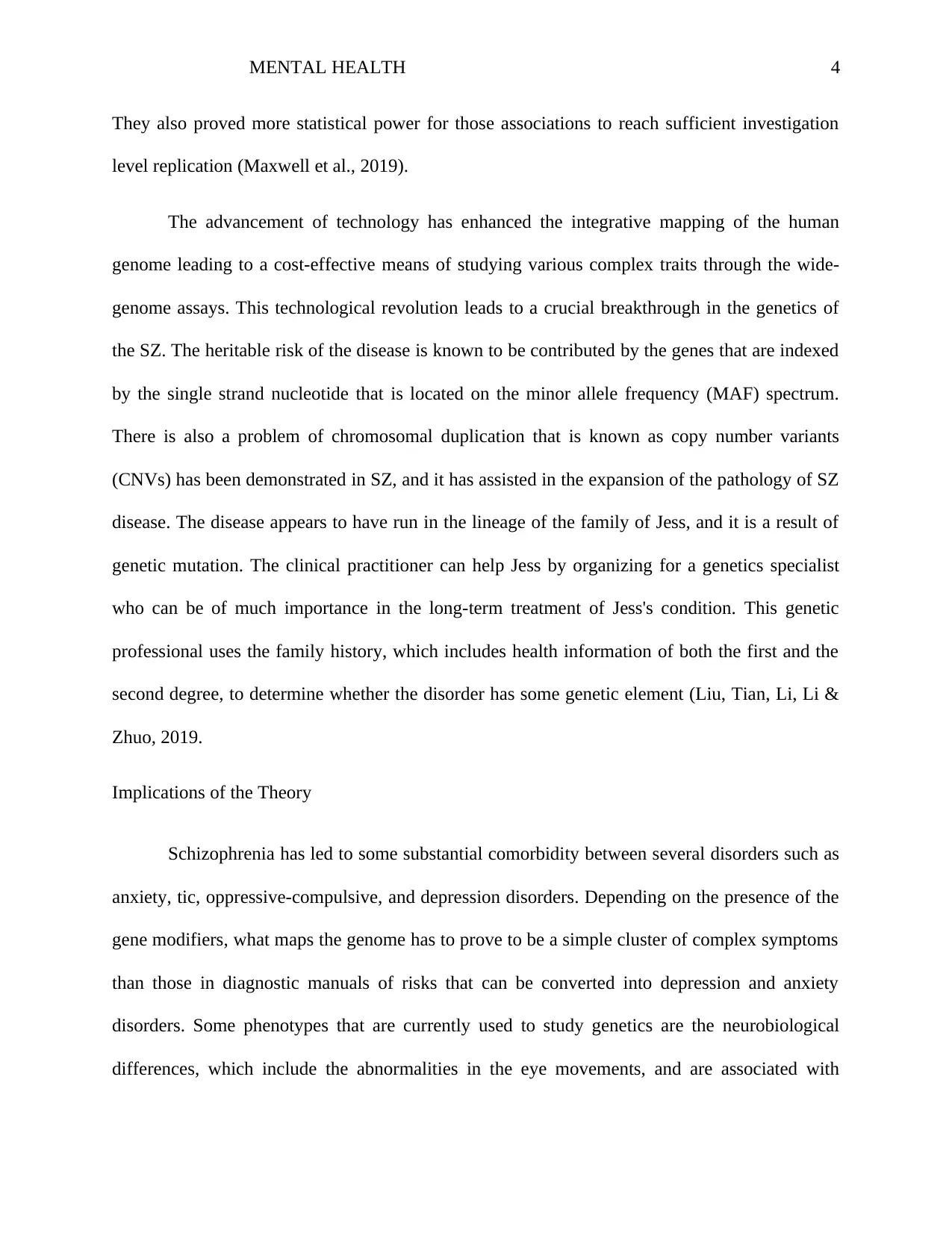
MENTAL HEALTH 4
They also proved more statistical power for those associations to reach sufficient investigation
level replication (Maxwell et al., 2019).
The advancement of technology has enhanced the integrative mapping of the human
genome leading to a cost-effective means of studying various complex traits through the wide-
genome assays. This technological revolution leads to a crucial breakthrough in the genetics of
the SZ. The heritable risk of the disease is known to be contributed by the genes that are indexed
by the single strand nucleotide that is located on the minor allele frequency (MAF) spectrum.
There is also a problem of chromosomal duplication that is known as copy number variants
(CNVs) has been demonstrated in SZ, and it has assisted in the expansion of the pathology of SZ
disease. The disease appears to have run in the lineage of the family of Jess, and it is a result of
genetic mutation. The clinical practitioner can help Jess by organizing for a genetics specialist
who can be of much importance in the long-term treatment of Jess's condition. This genetic
professional uses the family history, which includes health information of both the first and the
second degree, to determine whether the disorder has some genetic element (Liu, Tian, Li, Li &
Zhuo, 2019.
Implications of the Theory
Schizophrenia has led to some substantial comorbidity between several disorders such as
anxiety, tic, oppressive-compulsive, and depression disorders. Depending on the presence of the
gene modifiers, what maps the genome has to prove to be a simple cluster of complex symptoms
than those in diagnostic manuals of risks that can be converted into depression and anxiety
disorders. Some phenotypes that are currently used to study genetics are the neurobiological
differences, which include the abnormalities in the eye movements, and are associated with
They also proved more statistical power for those associations to reach sufficient investigation
level replication (Maxwell et al., 2019).
The advancement of technology has enhanced the integrative mapping of the human
genome leading to a cost-effective means of studying various complex traits through the wide-
genome assays. This technological revolution leads to a crucial breakthrough in the genetics of
the SZ. The heritable risk of the disease is known to be contributed by the genes that are indexed
by the single strand nucleotide that is located on the minor allele frequency (MAF) spectrum.
There is also a problem of chromosomal duplication that is known as copy number variants
(CNVs) has been demonstrated in SZ, and it has assisted in the expansion of the pathology of SZ
disease. The disease appears to have run in the lineage of the family of Jess, and it is a result of
genetic mutation. The clinical practitioner can help Jess by organizing for a genetics specialist
who can be of much importance in the long-term treatment of Jess's condition. This genetic
professional uses the family history, which includes health information of both the first and the
second degree, to determine whether the disorder has some genetic element (Liu, Tian, Li, Li &
Zhuo, 2019.
Implications of the Theory
Schizophrenia has led to some substantial comorbidity between several disorders such as
anxiety, tic, oppressive-compulsive, and depression disorders. Depending on the presence of the
gene modifiers, what maps the genome has to prove to be a simple cluster of complex symptoms
than those in diagnostic manuals of risks that can be converted into depression and anxiety
disorders. Some phenotypes that are currently used to study genetics are the neurobiological
differences, which include the abnormalities in the eye movements, and are associated with
Paraphrase This Document
Need a fresh take? Get an instant paraphrase of this document with our AI Paraphraser

MENTAL HEALTH 5
schizophrenia. The future advances in the cognitive neuroimaging and neuroscience, which
involve phenotype-based patterns on the brain functioning and the emergency of the
neurochemical differences. The discovery of the genes that are vulnerable to mental illness is an
important step in helping the nursing practice to resolve the boundaries of disease entities and
reduce the risk of transmission within the families (Widyaningrum, Yusuf & Tristiana, 2020).
Sometimes the psychiatrist diagnosis fails to designate the experiences of the mental
distress, and this can be regarded as a categorization process and not an intentional service meant
to maintain the oppressive power relation in the society. Mental health nursing practice has to
demonstrate the awareness of power-related inherent in a diagnostic process and try to re-address
the issues both at the individual and social, political levels. Many of the nursing standards
suggest that mental health nursing practice is a patient-centered relationship. Thus, nurses should
focus on the patient’s experience instead of focusing on the psychiatric diagnosis where the
experience is attributed. Therefore, mental health nurses should concentrate and offer themselves
to provide services to deliver the best in the nursing professional (Larkings, & Brown, 2018).
This implication can apply best to the NDIS workers who help the disability and the general
practitioner (GP), especially the mentally ill like Jess. While delivering the practices to Jess, the
GP and the NDIS workers should act as the role model or the directors in demonstrating the
essential services required to Jess. This will assist Jess's parents in learning and understanding
the best ways to treat their loved ones with regard to her condition and to avoid hurting her
feelings.
Environmental Theory of Schizophrenia
schizophrenia. The future advances in the cognitive neuroimaging and neuroscience, which
involve phenotype-based patterns on the brain functioning and the emergency of the
neurochemical differences. The discovery of the genes that are vulnerable to mental illness is an
important step in helping the nursing practice to resolve the boundaries of disease entities and
reduce the risk of transmission within the families (Widyaningrum, Yusuf & Tristiana, 2020).
Sometimes the psychiatrist diagnosis fails to designate the experiences of the mental
distress, and this can be regarded as a categorization process and not an intentional service meant
to maintain the oppressive power relation in the society. Mental health nursing practice has to
demonstrate the awareness of power-related inherent in a diagnostic process and try to re-address
the issues both at the individual and social, political levels. Many of the nursing standards
suggest that mental health nursing practice is a patient-centered relationship. Thus, nurses should
focus on the patient’s experience instead of focusing on the psychiatric diagnosis where the
experience is attributed. Therefore, mental health nurses should concentrate and offer themselves
to provide services to deliver the best in the nursing professional (Larkings, & Brown, 2018).
This implication can apply best to the NDIS workers who help the disability and the general
practitioner (GP), especially the mentally ill like Jess. While delivering the practices to Jess, the
GP and the NDIS workers should act as the role model or the directors in demonstrating the
essential services required to Jess. This will assist Jess's parents in learning and understanding
the best ways to treat their loved ones with regard to her condition and to avoid hurting her
feelings.
Environmental Theory of Schizophrenia

MENTAL HEALTH 6
The risk of psychosis in adulthood is associated with the presence of childhood trauma.
Many of the psychiatrist studies have shown that the high prevalence of childhood trauma during
childhood has been reported by the inpatients and outpatients, which is the reason for psychotic
disorders (Tikovsky, 2017). According to the case study, Jess has displayed some of the
schizophrenia symptoms like the abusive behavior, which was reported to have come from her
grandmother, who was formally her caretaker in her childhood.
Some of the current population-based researches have revealed evidence that there are
biological mechanisms that link the development of psychosis with childhood trauma. Some of
the childhood trauma that results in adverse experiences include; sexual, emotional, and physical
abuse. These long-term adverse repercussions of childhood, physical and sexual abuse are among
the documented determinants of the risks of adult depression, suicide drug, and alcohol
addiction, personality disorders, schizophrenia, and post-traumatic stress disorder (PTSD).
Sexual abuse is connected to mental disorders such as borderline personality and depression,
while physical abuse associated with an antisocial personality disorder. In recent years, the
research coalesced around the review of an article written by Read and colleagues claimed the
evidence that child abuse is the casual factors for schizophrenia and psychosis. According to the
case study, Jess might have been exposed to alcohol abuse within her residence, and this might
have triggered her into involvement in alcohol and misuse of drugs such as cannabis. Although
drugs do not cause schizophrenia directly, Jess has been misusing drugs such as alcohol and
cannabis, and it might have contributed to the development of schizophrenia and other related
mental illnesses (Misiak et al., 2018).
Some of the drugs that can trigger the symptoms of schizophrenia include; cannabis,
LSD, and cocaine. This can be the evidence of Jess’s condition, whereby she has been ever
The risk of psychosis in adulthood is associated with the presence of childhood trauma.
Many of the psychiatrist studies have shown that the high prevalence of childhood trauma during
childhood has been reported by the inpatients and outpatients, which is the reason for psychotic
disorders (Tikovsky, 2017). According to the case study, Jess has displayed some of the
schizophrenia symptoms like the abusive behavior, which was reported to have come from her
grandmother, who was formally her caretaker in her childhood.
Some of the current population-based researches have revealed evidence that there are
biological mechanisms that link the development of psychosis with childhood trauma. Some of
the childhood trauma that results in adverse experiences include; sexual, emotional, and physical
abuse. These long-term adverse repercussions of childhood, physical and sexual abuse are among
the documented determinants of the risks of adult depression, suicide drug, and alcohol
addiction, personality disorders, schizophrenia, and post-traumatic stress disorder (PTSD).
Sexual abuse is connected to mental disorders such as borderline personality and depression,
while physical abuse associated with an antisocial personality disorder. In recent years, the
research coalesced around the review of an article written by Read and colleagues claimed the
evidence that child abuse is the casual factors for schizophrenia and psychosis. According to the
case study, Jess might have been exposed to alcohol abuse within her residence, and this might
have triggered her into involvement in alcohol and misuse of drugs such as cannabis. Although
drugs do not cause schizophrenia directly, Jess has been misusing drugs such as alcohol and
cannabis, and it might have contributed to the development of schizophrenia and other related
mental illnesses (Misiak et al., 2018).
Some of the drugs that can trigger the symptoms of schizophrenia include; cannabis,
LSD, and cocaine. This can be the evidence of Jess’s condition, whereby she has been ever
⊘ This is a preview!⊘
Do you want full access?
Subscribe today to unlock all pages.

Trusted by 1+ million students worldwide
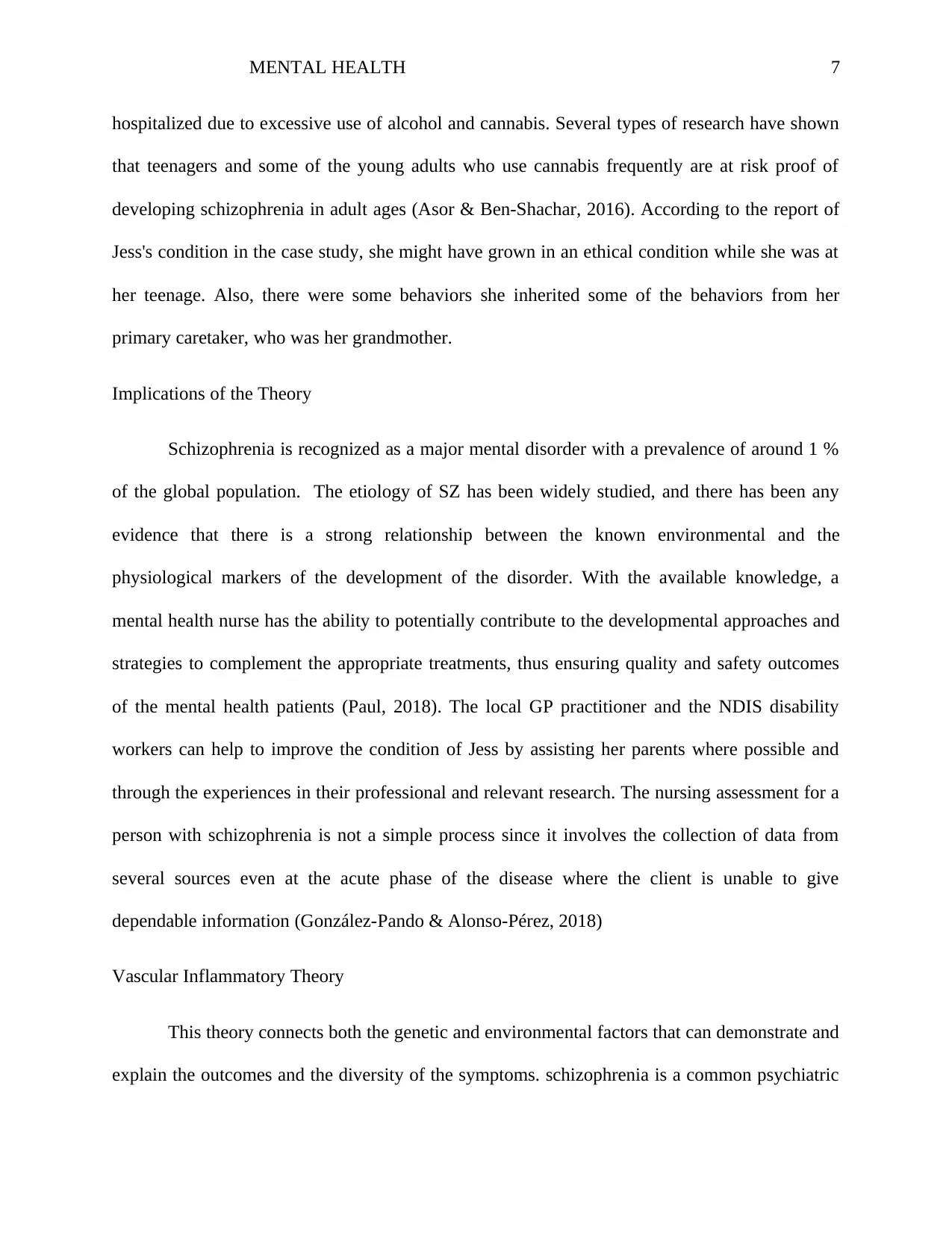
MENTAL HEALTH 7
hospitalized due to excessive use of alcohol and cannabis. Several types of research have shown
that teenagers and some of the young adults who use cannabis frequently are at risk proof of
developing schizophrenia in adult ages (Asor & Ben-Shachar, 2016). According to the report of
Jess's condition in the case study, she might have grown in an ethical condition while she was at
her teenage. Also, there were some behaviors she inherited some of the behaviors from her
primary caretaker, who was her grandmother.
Implications of the Theory
Schizophrenia is recognized as a major mental disorder with a prevalence of around 1 %
of the global population. The etiology of SZ has been widely studied, and there has been any
evidence that there is a strong relationship between the known environmental and the
physiological markers of the development of the disorder. With the available knowledge, a
mental health nurse has the ability to potentially contribute to the developmental approaches and
strategies to complement the appropriate treatments, thus ensuring quality and safety outcomes
of the mental health patients (Paul, 2018). The local GP practitioner and the NDIS disability
workers can help to improve the condition of Jess by assisting her parents where possible and
through the experiences in their professional and relevant research. The nursing assessment for a
person with schizophrenia is not a simple process since it involves the collection of data from
several sources even at the acute phase of the disease where the client is unable to give
dependable information (González-Pando & Alonso-Pérez, 2018)
Vascular Inflammatory Theory
This theory connects both the genetic and environmental factors that can demonstrate and
explain the outcomes and the diversity of the symptoms. schizophrenia is a common psychiatric
hospitalized due to excessive use of alcohol and cannabis. Several types of research have shown
that teenagers and some of the young adults who use cannabis frequently are at risk proof of
developing schizophrenia in adult ages (Asor & Ben-Shachar, 2016). According to the report of
Jess's condition in the case study, she might have grown in an ethical condition while she was at
her teenage. Also, there were some behaviors she inherited some of the behaviors from her
primary caretaker, who was her grandmother.
Implications of the Theory
Schizophrenia is recognized as a major mental disorder with a prevalence of around 1 %
of the global population. The etiology of SZ has been widely studied, and there has been any
evidence that there is a strong relationship between the known environmental and the
physiological markers of the development of the disorder. With the available knowledge, a
mental health nurse has the ability to potentially contribute to the developmental approaches and
strategies to complement the appropriate treatments, thus ensuring quality and safety outcomes
of the mental health patients (Paul, 2018). The local GP practitioner and the NDIS disability
workers can help to improve the condition of Jess by assisting her parents where possible and
through the experiences in their professional and relevant research. The nursing assessment for a
person with schizophrenia is not a simple process since it involves the collection of data from
several sources even at the acute phase of the disease where the client is unable to give
dependable information (González-Pando & Alonso-Pérez, 2018)
Vascular Inflammatory Theory
This theory connects both the genetic and environmental factors that can demonstrate and
explain the outcomes and the diversity of the symptoms. schizophrenia is a common psychiatric
Paraphrase This Document
Need a fresh take? Get an instant paraphrase of this document with our AI Paraphraser

MENTAL HEALTH 8
syndrome that virtually affects the functioning of the brain. Regardless of the developmental
process of the disease, there are abnormalities in the neurons and their synaptic connections. The
inability to measure the pathophysiology of schizophrenia brings about a challenge towards the
theoretical models and the beliefs (Najjar, Pahlajani, Sanctis, Stern, Najjar & Chong, 2017). The
more research to satisfy the model of the characteristic of SZ reveals that the central nervous
system (CNS) microvascular inflammatory disease is mediated genetically. The theory suggests
that the physiological abnormalities that lead to the disorder involve the disruption of the precise
regulation in the delivery of oxygen and energy that is vital to the functioning of the brain
(Katsel, Roussos, Pletnikov & Haroutunian, 2017).
The theory also posits that the CNS metabolism abnormalities develop due to the
genetically controlled inflammatory responses which damage the vascular system of the brain.
This response results due to the reaction towards the environmental agents, which includes
infections, physical trauma, and hypoxia. The damage can worsen when one is exposed to the
triggering agents, which leads to deterioration and exacerbation or healing after they are
withdrawn (Cardoso & Silva, 2018). According to Jess's case, her grandmother did not caution
her well concerning the use of the drugs of which she was involved in and hence triggering the
development of her schizophrenia illness. Jess’s grandmother might not have had much
knowledge concerning her condition that she had no clue whether there is such a mental disorder
in their family.
Implications of the Theory
A mental health nurse can learn a lot while taking care of a person with schizophrenia
since the treatment of the condition is a life-long process. With the help of the general
practitioner and the NDIS disability worker, Jess’s parents will have a chance to learn more
syndrome that virtually affects the functioning of the brain. Regardless of the developmental
process of the disease, there are abnormalities in the neurons and their synaptic connections. The
inability to measure the pathophysiology of schizophrenia brings about a challenge towards the
theoretical models and the beliefs (Najjar, Pahlajani, Sanctis, Stern, Najjar & Chong, 2017). The
more research to satisfy the model of the characteristic of SZ reveals that the central nervous
system (CNS) microvascular inflammatory disease is mediated genetically. The theory suggests
that the physiological abnormalities that lead to the disorder involve the disruption of the precise
regulation in the delivery of oxygen and energy that is vital to the functioning of the brain
(Katsel, Roussos, Pletnikov & Haroutunian, 2017).
The theory also posits that the CNS metabolism abnormalities develop due to the
genetically controlled inflammatory responses which damage the vascular system of the brain.
This response results due to the reaction towards the environmental agents, which includes
infections, physical trauma, and hypoxia. The damage can worsen when one is exposed to the
triggering agents, which leads to deterioration and exacerbation or healing after they are
withdrawn (Cardoso & Silva, 2018). According to Jess's case, her grandmother did not caution
her well concerning the use of the drugs of which she was involved in and hence triggering the
development of her schizophrenia illness. Jess’s grandmother might not have had much
knowledge concerning her condition that she had no clue whether there is such a mental disorder
in their family.
Implications of the Theory
A mental health nurse can learn a lot while taking care of a person with schizophrenia
since the treatment of the condition is a life-long process. With the help of the general
practitioner and the NDIS disability worker, Jess’s parents will have a chance to learn more
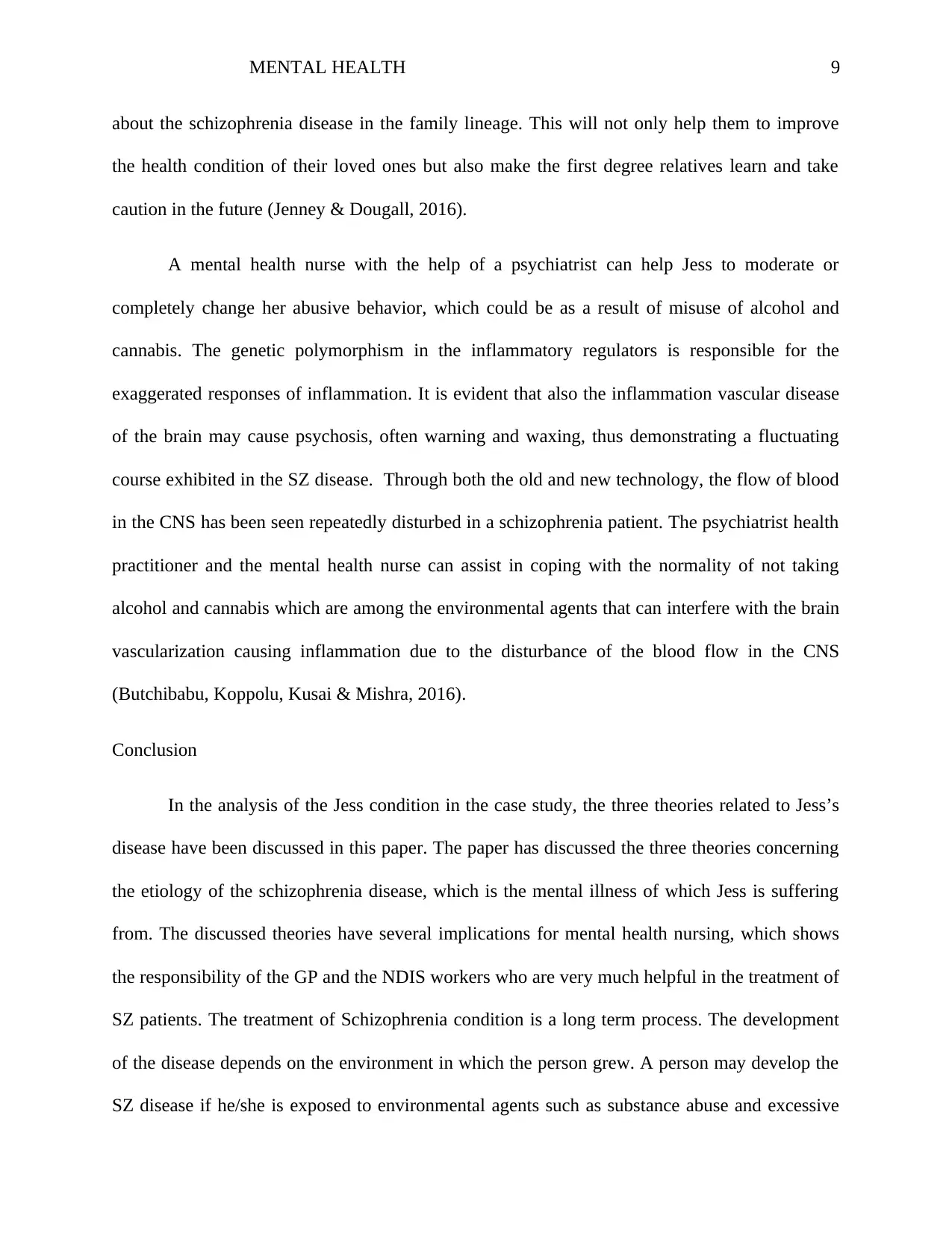
MENTAL HEALTH 9
about the schizophrenia disease in the family lineage. This will not only help them to improve
the health condition of their loved ones but also make the first degree relatives learn and take
caution in the future (Jenney & Dougall, 2016).
A mental health nurse with the help of a psychiatrist can help Jess to moderate or
completely change her abusive behavior, which could be as a result of misuse of alcohol and
cannabis. The genetic polymorphism in the inflammatory regulators is responsible for the
exaggerated responses of inflammation. It is evident that also the inflammation vascular disease
of the brain may cause psychosis, often warning and waxing, thus demonstrating a fluctuating
course exhibited in the SZ disease. Through both the old and new technology, the flow of blood
in the CNS has been seen repeatedly disturbed in a schizophrenia patient. The psychiatrist health
practitioner and the mental health nurse can assist in coping with the normality of not taking
alcohol and cannabis which are among the environmental agents that can interfere with the brain
vascularization causing inflammation due to the disturbance of the blood flow in the CNS
(Butchibabu, Koppolu, Kusai & Mishra, 2016).
Conclusion
In the analysis of the Jess condition in the case study, the three theories related to Jess’s
disease have been discussed in this paper. The paper has discussed the three theories concerning
the etiology of the schizophrenia disease, which is the mental illness of which Jess is suffering
from. The discussed theories have several implications for mental health nursing, which shows
the responsibility of the GP and the NDIS workers who are very much helpful in the treatment of
SZ patients. The treatment of Schizophrenia condition is a long term process. The development
of the disease depends on the environment in which the person grew. A person may develop the
SZ disease if he/she is exposed to environmental agents such as substance abuse and excessive
about the schizophrenia disease in the family lineage. This will not only help them to improve
the health condition of their loved ones but also make the first degree relatives learn and take
caution in the future (Jenney & Dougall, 2016).
A mental health nurse with the help of a psychiatrist can help Jess to moderate or
completely change her abusive behavior, which could be as a result of misuse of alcohol and
cannabis. The genetic polymorphism in the inflammatory regulators is responsible for the
exaggerated responses of inflammation. It is evident that also the inflammation vascular disease
of the brain may cause psychosis, often warning and waxing, thus demonstrating a fluctuating
course exhibited in the SZ disease. Through both the old and new technology, the flow of blood
in the CNS has been seen repeatedly disturbed in a schizophrenia patient. The psychiatrist health
practitioner and the mental health nurse can assist in coping with the normality of not taking
alcohol and cannabis which are among the environmental agents that can interfere with the brain
vascularization causing inflammation due to the disturbance of the blood flow in the CNS
(Butchibabu, Koppolu, Kusai & Mishra, 2016).
Conclusion
In the analysis of the Jess condition in the case study, the three theories related to Jess’s
disease have been discussed in this paper. The paper has discussed the three theories concerning
the etiology of the schizophrenia disease, which is the mental illness of which Jess is suffering
from. The discussed theories have several implications for mental health nursing, which shows
the responsibility of the GP and the NDIS workers who are very much helpful in the treatment of
SZ patients. The treatment of Schizophrenia condition is a long term process. The development
of the disease depends on the environment in which the person grew. A person may develop the
SZ disease if he/she is exposed to environmental agents such as substance abuse and excessive
⊘ This is a preview!⊘
Do you want full access?
Subscribe today to unlock all pages.

Trusted by 1+ million students worldwide
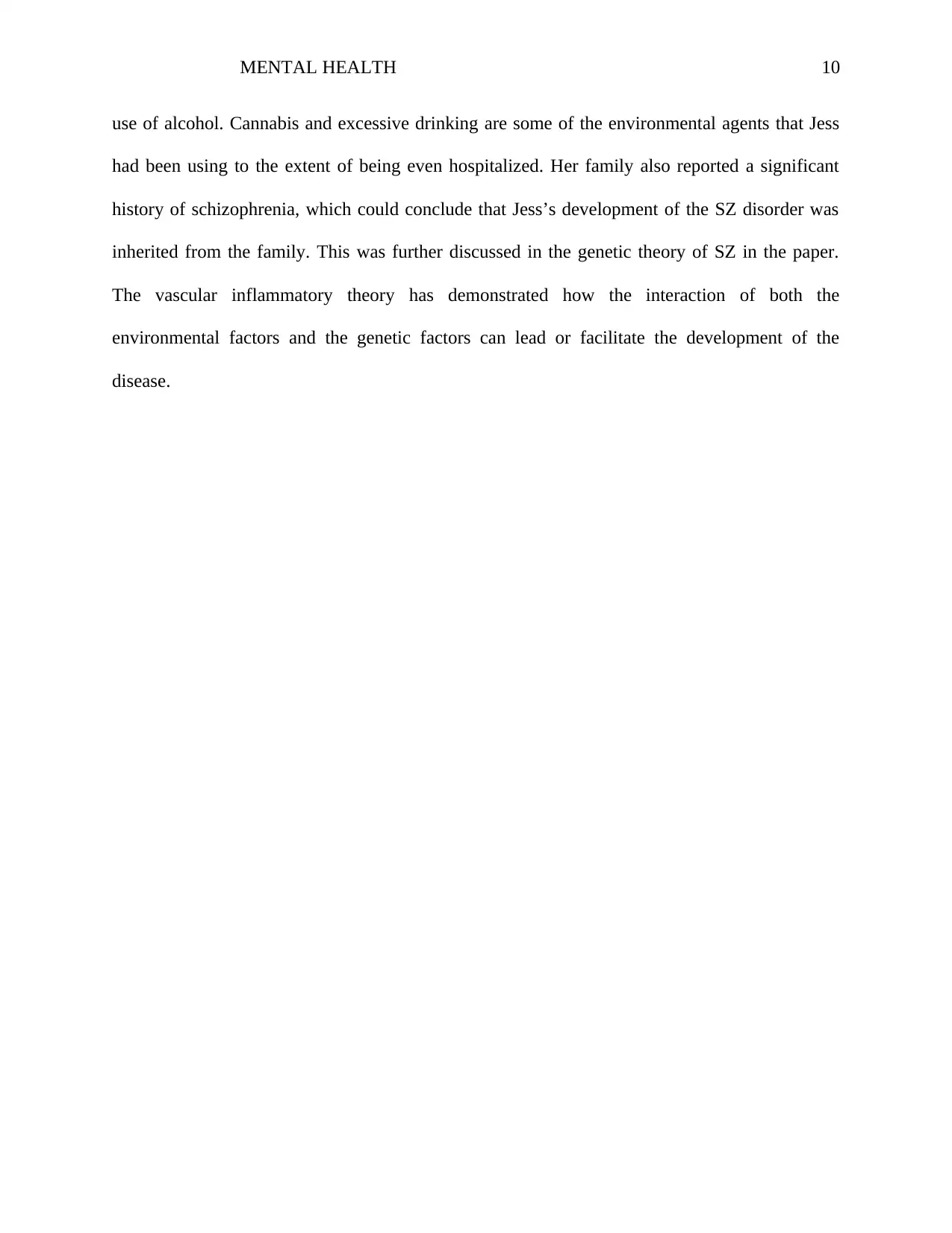
MENTAL HEALTH 10
use of alcohol. Cannabis and excessive drinking are some of the environmental agents that Jess
had been using to the extent of being even hospitalized. Her family also reported a significant
history of schizophrenia, which could conclude that Jess’s development of the SZ disorder was
inherited from the family. This was further discussed in the genetic theory of SZ in the paper.
The vascular inflammatory theory has demonstrated how the interaction of both the
environmental factors and the genetic factors can lead or facilitate the development of the
disease.
use of alcohol. Cannabis and excessive drinking are some of the environmental agents that Jess
had been using to the extent of being even hospitalized. Her family also reported a significant
history of schizophrenia, which could conclude that Jess’s development of the SZ disorder was
inherited from the family. This was further discussed in the genetic theory of SZ in the paper.
The vascular inflammatory theory has demonstrated how the interaction of both the
environmental factors and the genetic factors can lead or facilitate the development of the
disease.
Paraphrase This Document
Need a fresh take? Get an instant paraphrase of this document with our AI Paraphraser
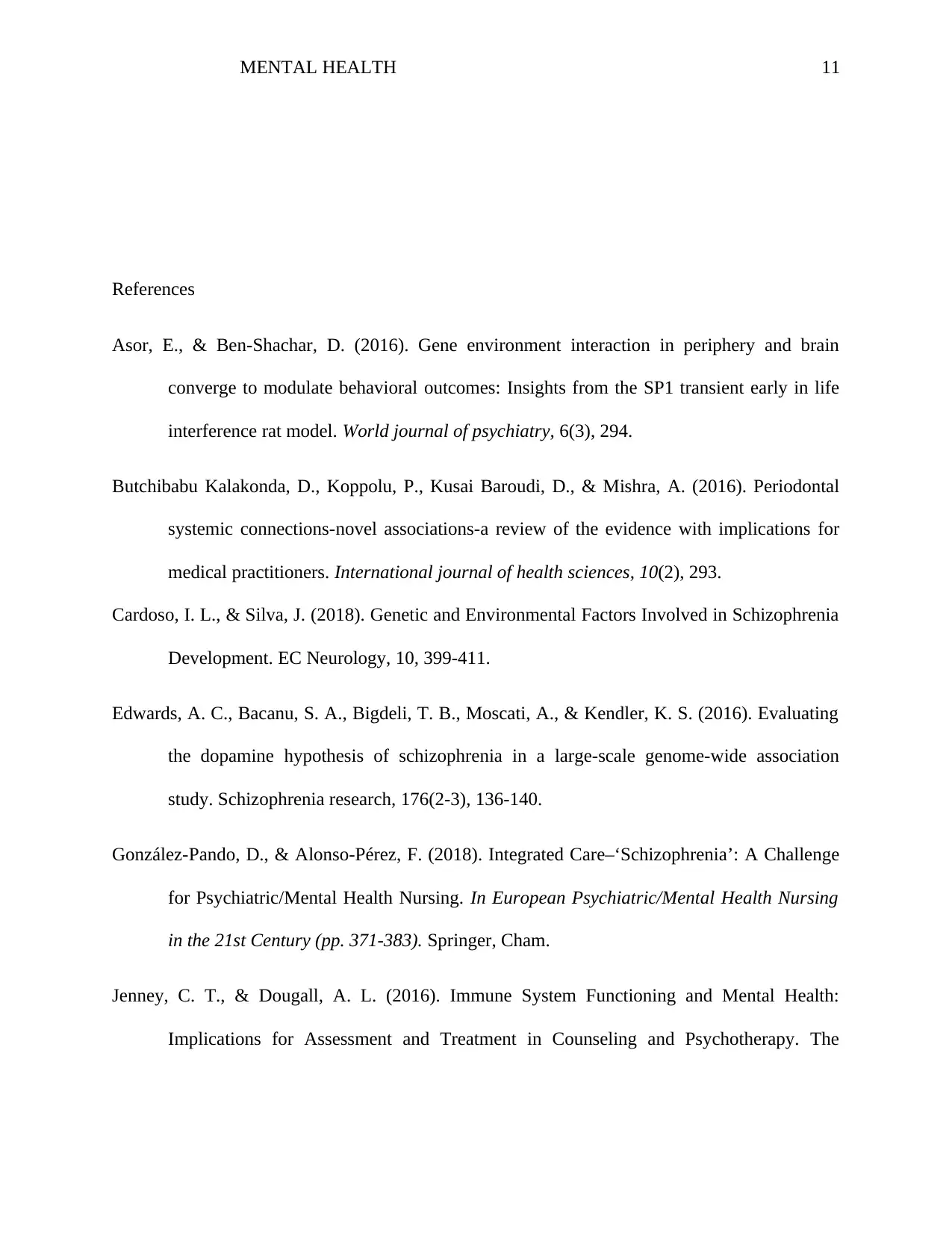
MENTAL HEALTH 11
References
Asor, E., & Ben-Shachar, D. (2016). Gene environment interaction in periphery and brain
converge to modulate behavioral outcomes: Insights from the SP1 transient early in life
interference rat model. World journal of psychiatry, 6(3), 294.
Butchibabu Kalakonda, D., Koppolu, P., Kusai Baroudi, D., & Mishra, A. (2016). Periodontal
systemic connections-novel associations-a review of the evidence with implications for
medical practitioners. International journal of health sciences, 10(2), 293.
Cardoso, I. L., & Silva, J. (2018). Genetic and Environmental Factors Involved in Schizophrenia
Development. EC Neurology, 10, 399-411.
Edwards, A. C., Bacanu, S. A., Bigdeli, T. B., Moscati, A., & Kendler, K. S. (2016). Evaluating
the dopamine hypothesis of schizophrenia in a large-scale genome-wide association
study. Schizophrenia research, 176(2-3), 136-140.
González-Pando, D., & Alonso-Pérez, F. (2018). Integrated Care–‘Schizophrenia’: A Challenge
for Psychiatric/Mental Health Nursing. In European Psychiatric/Mental Health Nursing
in the 21st Century (pp. 371-383). Springer, Cham.
Jenney, C. T., & Dougall, A. L. (2016). Immune System Functioning and Mental Health:
Implications for Assessment and Treatment in Counseling and Psychotherapy. The
References
Asor, E., & Ben-Shachar, D. (2016). Gene environment interaction in periphery and brain
converge to modulate behavioral outcomes: Insights from the SP1 transient early in life
interference rat model. World journal of psychiatry, 6(3), 294.
Butchibabu Kalakonda, D., Koppolu, P., Kusai Baroudi, D., & Mishra, A. (2016). Periodontal
systemic connections-novel associations-a review of the evidence with implications for
medical practitioners. International journal of health sciences, 10(2), 293.
Cardoso, I. L., & Silva, J. (2018). Genetic and Environmental Factors Involved in Schizophrenia
Development. EC Neurology, 10, 399-411.
Edwards, A. C., Bacanu, S. A., Bigdeli, T. B., Moscati, A., & Kendler, K. S. (2016). Evaluating
the dopamine hypothesis of schizophrenia in a large-scale genome-wide association
study. Schizophrenia research, 176(2-3), 136-140.
González-Pando, D., & Alonso-Pérez, F. (2018). Integrated Care–‘Schizophrenia’: A Challenge
for Psychiatric/Mental Health Nursing. In European Psychiatric/Mental Health Nursing
in the 21st Century (pp. 371-383). Springer, Cham.
Jenney, C. T., & Dougall, A. L. (2016). Immune System Functioning and Mental Health:
Implications for Assessment and Treatment in Counseling and Psychotherapy. The
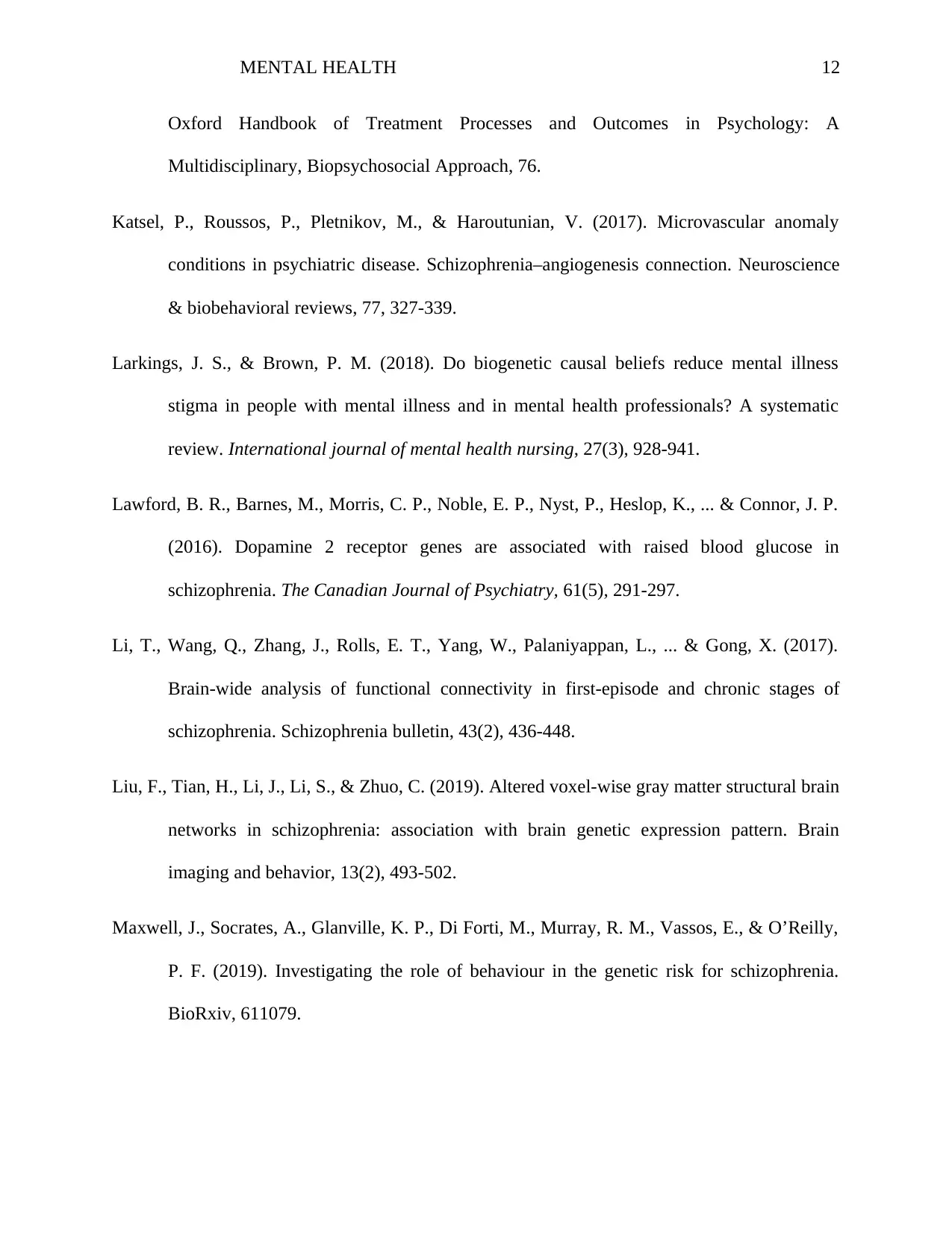
MENTAL HEALTH 12
Oxford Handbook of Treatment Processes and Outcomes in Psychology: A
Multidisciplinary, Biopsychosocial Approach, 76.
Katsel, P., Roussos, P., Pletnikov, M., & Haroutunian, V. (2017). Microvascular anomaly
conditions in psychiatric disease. Schizophrenia–angiogenesis connection. Neuroscience
& biobehavioral reviews, 77, 327-339.
Larkings, J. S., & Brown, P. M. (2018). Do biogenetic causal beliefs reduce mental illness
stigma in people with mental illness and in mental health professionals? A systematic
review. International journal of mental health nursing, 27(3), 928-941.
Lawford, B. R., Barnes, M., Morris, C. P., Noble, E. P., Nyst, P., Heslop, K., ... & Connor, J. P.
(2016). Dopamine 2 receptor genes are associated with raised blood glucose in
schizophrenia. The Canadian Journal of Psychiatry, 61(5), 291-297.
Li, T., Wang, Q., Zhang, J., Rolls, E. T., Yang, W., Palaniyappan, L., ... & Gong, X. (2017).
Brain-wide analysis of functional connectivity in first-episode and chronic stages of
schizophrenia. Schizophrenia bulletin, 43(2), 436-448.
Liu, F., Tian, H., Li, J., Li, S., & Zhuo, C. (2019). Altered voxel-wise gray matter structural brain
networks in schizophrenia: association with brain genetic expression pattern. Brain
imaging and behavior, 13(2), 493-502.
Maxwell, J., Socrates, A., Glanville, K. P., Di Forti, M., Murray, R. M., Vassos, E., & O’Reilly,
P. F. (2019). Investigating the role of behaviour in the genetic risk for schizophrenia.
BioRxiv, 611079.
Oxford Handbook of Treatment Processes and Outcomes in Psychology: A
Multidisciplinary, Biopsychosocial Approach, 76.
Katsel, P., Roussos, P., Pletnikov, M., & Haroutunian, V. (2017). Microvascular anomaly
conditions in psychiatric disease. Schizophrenia–angiogenesis connection. Neuroscience
& biobehavioral reviews, 77, 327-339.
Larkings, J. S., & Brown, P. M. (2018). Do biogenetic causal beliefs reduce mental illness
stigma in people with mental illness and in mental health professionals? A systematic
review. International journal of mental health nursing, 27(3), 928-941.
Lawford, B. R., Barnes, M., Morris, C. P., Noble, E. P., Nyst, P., Heslop, K., ... & Connor, J. P.
(2016). Dopamine 2 receptor genes are associated with raised blood glucose in
schizophrenia. The Canadian Journal of Psychiatry, 61(5), 291-297.
Li, T., Wang, Q., Zhang, J., Rolls, E. T., Yang, W., Palaniyappan, L., ... & Gong, X. (2017).
Brain-wide analysis of functional connectivity in first-episode and chronic stages of
schizophrenia. Schizophrenia bulletin, 43(2), 436-448.
Liu, F., Tian, H., Li, J., Li, S., & Zhuo, C. (2019). Altered voxel-wise gray matter structural brain
networks in schizophrenia: association with brain genetic expression pattern. Brain
imaging and behavior, 13(2), 493-502.
Maxwell, J., Socrates, A., Glanville, K. P., Di Forti, M., Murray, R. M., Vassos, E., & O’Reilly,
P. F. (2019). Investigating the role of behaviour in the genetic risk for schizophrenia.
BioRxiv, 611079.
⊘ This is a preview!⊘
Do you want full access?
Subscribe today to unlock all pages.

Trusted by 1+ million students worldwide
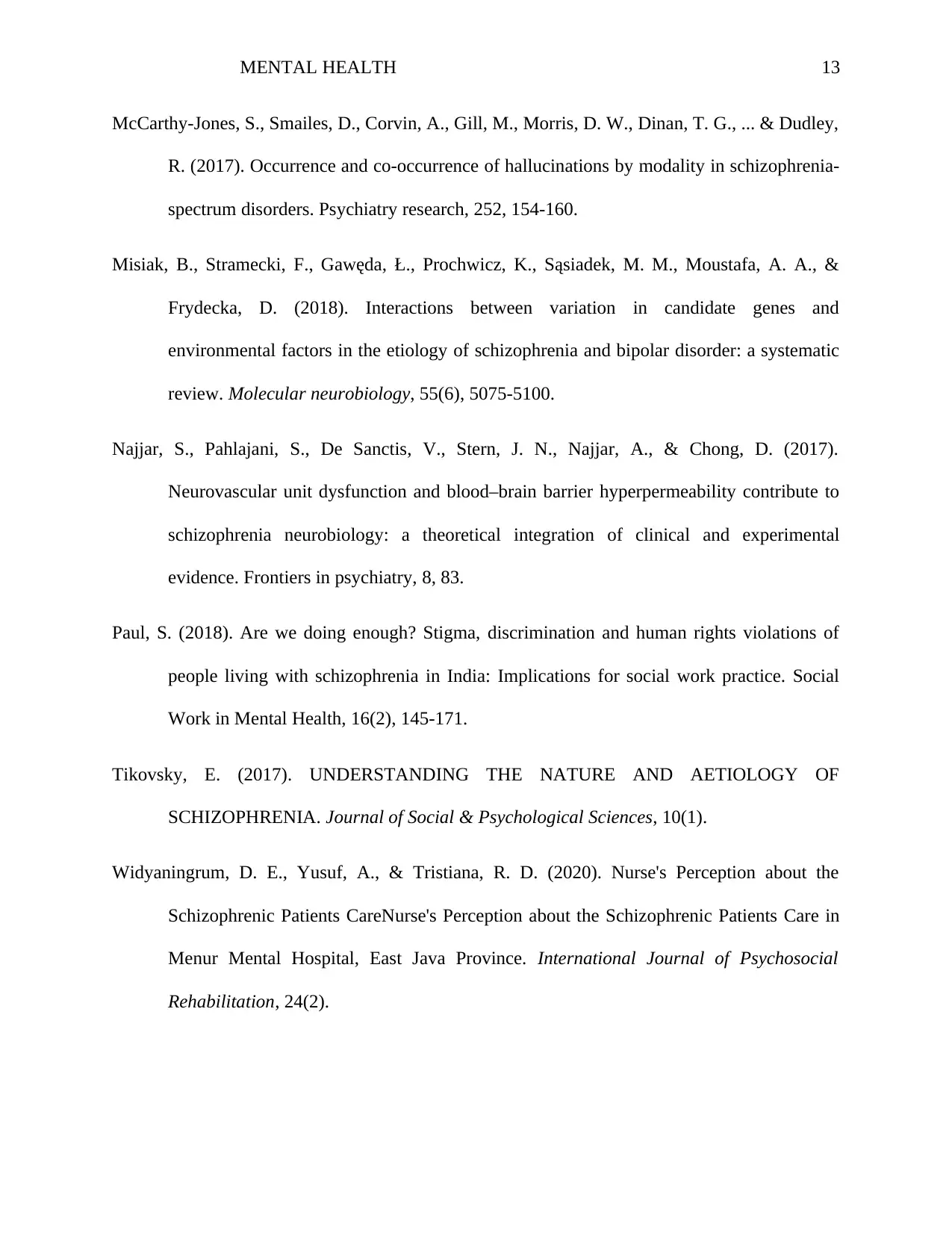
MENTAL HEALTH 13
McCarthy-Jones, S., Smailes, D., Corvin, A., Gill, M., Morris, D. W., Dinan, T. G., ... & Dudley,
R. (2017). Occurrence and co-occurrence of hallucinations by modality in schizophrenia-
spectrum disorders. Psychiatry research, 252, 154-160.
Misiak, B., Stramecki, F., Gawęda, Ł., Prochwicz, K., Sąsiadek, M. M., Moustafa, A. A., &
Frydecka, D. (2018). Interactions between variation in candidate genes and
environmental factors in the etiology of schizophrenia and bipolar disorder: a systematic
review. Molecular neurobiology, 55(6), 5075-5100.
Najjar, S., Pahlajani, S., De Sanctis, V., Stern, J. N., Najjar, A., & Chong, D. (2017).
Neurovascular unit dysfunction and blood–brain barrier hyperpermeability contribute to
schizophrenia neurobiology: a theoretical integration of clinical and experimental
evidence. Frontiers in psychiatry, 8, 83.
Paul, S. (2018). Are we doing enough? Stigma, discrimination and human rights violations of
people living with schizophrenia in India: Implications for social work practice. Social
Work in Mental Health, 16(2), 145-171.
Tikovsky, E. (2017). UNDERSTANDING THE NATURE AND AETIOLOGY OF
SCHIZOPHRENIA. Journal of Social & Psychological Sciences, 10(1).
Widyaningrum, D. E., Yusuf, A., & Tristiana, R. D. (2020). Nurse's Perception about the
Schizophrenic Patients CareNurse's Perception about the Schizophrenic Patients Care in
Menur Mental Hospital, East Java Province. International Journal of Psychosocial
Rehabilitation, 24(2).
McCarthy-Jones, S., Smailes, D., Corvin, A., Gill, M., Morris, D. W., Dinan, T. G., ... & Dudley,
R. (2017). Occurrence and co-occurrence of hallucinations by modality in schizophrenia-
spectrum disorders. Psychiatry research, 252, 154-160.
Misiak, B., Stramecki, F., Gawęda, Ł., Prochwicz, K., Sąsiadek, M. M., Moustafa, A. A., &
Frydecka, D. (2018). Interactions between variation in candidate genes and
environmental factors in the etiology of schizophrenia and bipolar disorder: a systematic
review. Molecular neurobiology, 55(6), 5075-5100.
Najjar, S., Pahlajani, S., De Sanctis, V., Stern, J. N., Najjar, A., & Chong, D. (2017).
Neurovascular unit dysfunction and blood–brain barrier hyperpermeability contribute to
schizophrenia neurobiology: a theoretical integration of clinical and experimental
evidence. Frontiers in psychiatry, 8, 83.
Paul, S. (2018). Are we doing enough? Stigma, discrimination and human rights violations of
people living with schizophrenia in India: Implications for social work practice. Social
Work in Mental Health, 16(2), 145-171.
Tikovsky, E. (2017). UNDERSTANDING THE NATURE AND AETIOLOGY OF
SCHIZOPHRENIA. Journal of Social & Psychological Sciences, 10(1).
Widyaningrum, D. E., Yusuf, A., & Tristiana, R. D. (2020). Nurse's Perception about the
Schizophrenic Patients CareNurse's Perception about the Schizophrenic Patients Care in
Menur Mental Hospital, East Java Province. International Journal of Psychosocial
Rehabilitation, 24(2).
1 out of 13
Related Documents
Your All-in-One AI-Powered Toolkit for Academic Success.
+13062052269
info@desklib.com
Available 24*7 on WhatsApp / Email
![[object Object]](/_next/static/media/star-bottom.7253800d.svg)
Unlock your academic potential
© 2024 | Zucol Services PVT LTD | All rights reserved.





